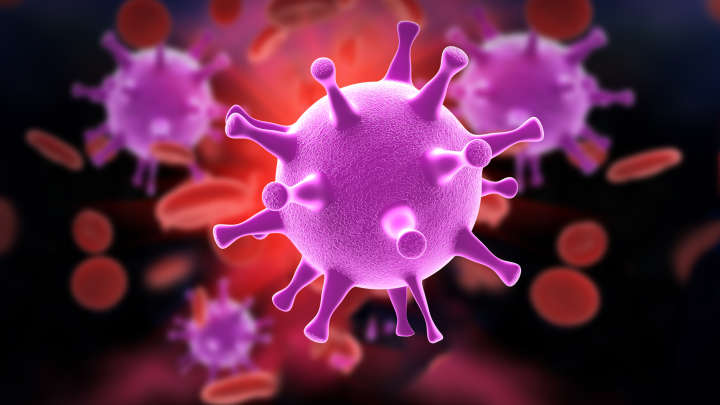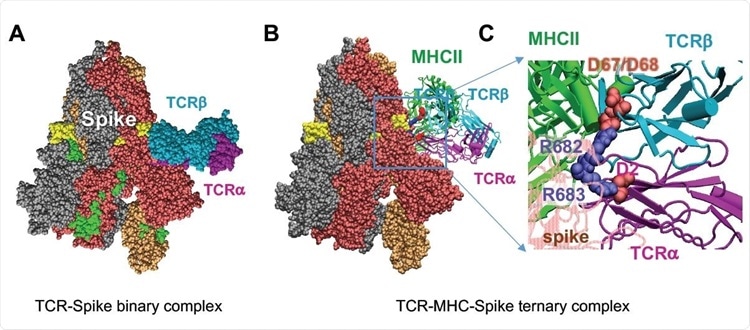COVID-19 Discoveries: Researchers Uncover Unique T Cell Receptor Repertoire In MIS-C Patients Commonly Associated With Superantigen Selection
Source: COVID-19 Discoveries Nov 12, 2020 5 years, 3 weeks, 4 days, 7 hours, 26 minutes ago
COVID-19 Discoveries: Researchers from Cedars-Sinai Medical Center-California, Martin-Luther-University, HalleWittenberg-Germany, University of California-Los Angeles, University of Pittsburgh, Boston, Massachusetts General Hospital and Loma Linda University Hospital-California have in a new study discovered a unique t cell receptor repertoire in MIS-C patients commonly associated with superantigen selection.

MIS-C or multisystem inflammatory syndrome in children, a hyperinflammatory syndrome associated with SARS-CoV-2 infection, shares many clinical features with toxic shock syndrome, which is triggered by bacterial superantigens. The superantigen specificity for binding different Vβ-chains results in Vβ-skewing, whereby T cells with specific Vβ-chains and diverse antigen specificity are overrepresented in the TCR repertoire.
In the study the researchers characterized the TCR repertoire of MIS-C patients and found a profound expansion of TCR Βeta Variable gene (TRBV)11-2. Furthermore, TRBV11-2 skewing was remarkably correlated with MIS-C severity and serum cytokine levels. Detailed analysis of TRBJ gene usage and CDR3 length distribution of MIS-C expanding TRBV11-2 clones revealed extensive junctional diversity, indicating a superantigenmediated selection process for TRBV expansion. In silico modelling indicates that polyacidic residues in TCR Vb11-2 engage in strong interactions with the superantigen-like motif of SARSCoV-2 spike glycoprotein. Overall, the data indicate that the immune response in MIS-C is consistent with superantigenic activation.
The study findings were published on a preprint server but are currently being peer reviewed.
https://www.biorxiv.org/content/10.1101/2020.11.09.372169v1
The study findings also indirectly confirms an earlier study that MIS-C is caused by a superantigenic mutated strain of the SARS-CoV-2 known as D839Y/N/E
https://www.thailandmedical.news/news/breaking-covid-19-news-mutated-sars-cov-2-strain-d839y-n-e-with-super-antigens-inserts-identified-as-cause-of-multi-inflammatory-syndrome-mis-c-and-mi
It has been found that children with COVID-19 sometimes develop the Multisystem Inflammatory Syndrome in Children (MIS-C), which is associated with high morbidity.
TSS or toxic shock syndrome and MIS-C share many similarities, with extensive and unregulated inflammation being characteristic of both. This study examined the occurrence of hyperinflammation in multiple body systems in children with COVID-19. These children experienced abdominal pain, diarrhea and rashes or had a weakening of the heart, sometimes involving cardiogenic shock. Strangely, these were not associated with severe respiratory symptoms. This suggests that MIS-C is due to extrapulmonary SARS-CoV-2 infection or a post-infectious inflammatory response.
Toxic shock syndrome or TSS is also similar and is the result of superantigen stimulation, such as by Staphylococcal enterotoxin B (SEB). Superantigens are bacterial molecules that are very powerful at binding T cell receptors (TCR)
and MHC class II molecules.
The former binding engages specific beta-chains of the TCRs, involving their variable domains without having to rely on the complementary-determining region-3 (CDR3). This allows them to directly and nonspecifically activate the T cells and induce their proliferation, as well as elicit the unregulated hyperinflammatory cytokine-driven response (called a cytokine storm).
Importantly specific superantigens bind to different TCR V-beta chains, and therefore T cells with these specific V-beta chains which bind to a diverse range of antigens will be overexpressed in these patients.
This study is based on the presence of a superantigen-like motif in the SARS-CoV-2 spike antigen. This binds to TCRs with high affinity as well as to MHC class II, forming a three-way complex. This motif closely resembles a staphylococcal superantigen in terms of sequence and structure. The TCR V-beta skewing seen in adults with severe hyperinflammatory COVID-19 phenotypes is similar to the type of immune response seen in superantigen-induced responses.
 Complex Formation Between SARS-CoV-2 spike, TCR Containing Vβ11-2, and MHCII, and Comparative Analysis of TCR Vβ Sequences Homologous to Vβ11-2. (A) Binding of TCR (with Vβ chain sequentially identical to that of TRBV11-2 gene product) to the SAg-like region of SARS-CoV-2 spike. The TCR α- and β-chains are shown in magenta and cyan, respectively. The β-chain tightly binds the SAg-like region (E661 to R685; colored yellow). The spike subunits are colored dark red, beige, and gray; and the neurotoxin motif (299-356), green. (B-C) Ternary complex between spike, the same TCR and MHCII (green and the close-up view of the interfacial interactions between two basic residues, R682 and R683, on the SAg-like region of spike and the acidic residues (D67 and D68) of the TCR Vβ (D67 and D68) and TCRα.
Complex Formation Between SARS-CoV-2 spike, TCR Containing Vβ11-2, and MHCII, and Comparative Analysis of TCR Vβ Sequences Homologous to Vβ11-2. (A) Binding of TCR (with Vβ chain sequentially identical to that of TRBV11-2 gene product) to the SAg-like region of SARS-CoV-2 spike. The TCR α- and β-chains are shown in magenta and cyan, respectively. The β-chain tightly binds the SAg-like region (E661 to R685; colored yellow). The spike subunits are colored dark red, beige, and gray; and the neurotoxin motif (299-356), green. (B-C) Ternary complex between spike, the same TCR and MHCII (green and the close-up view of the interfacial interactions between two basic residues, R682 and R683, on the SAg-like region of spike and the acidic residues (D67 and D68) of the TCR Vβ (D67 and D68) and TCRα.
The study team explored the TCR range of expression in MIS-C with reference to V-beta skewing and signs of superantigen activation. The team found that the TCR beta variable gene 11-2 (TRBV11-2) was greatly expanded. In mild MIS-C, there was a wider range of TCRs, just as in mild adult COVID-19, compared with severe MIS-C or COVID-19.
The team found that MIS-C patients showed an expansion of TRBV genes compared to patients with fever but without a SARS-CoV-2 infection. In severe disease, specific TRBV genes were exclusively over-represented, namely, TRBV11-2, TRBV24-1, and TRBV11-3 compared to either control with only fever or mild MIS-C patients.
Interestingly the latter showed an expansion of TRBV-28 alone. Again, TRBV11-2 usage was correlated with the expression of inflammatory cytokines such as TNF-α, IFN-γ, IL-6 and IL-10 and with severe pediatric disease. This pattern was found to hold good irrespective of age in the severe MIS-C group.
Furthermore, TRBV11-2 expansion correlated with PCR positivity rather than positive serology results. Over half the patients with this pattern were PCR positive, compared to zero patients without TRBV11-2 expansion. This data indicates an “association of TRBV11-2 expansion with active SARS-CoV-2 infection.”
As CDR3 is not involved in superantigen interactions, the study team expected a high degree of junctional diversity at the V(D)J junction in TCR with TRBV11-2 usage in severe MIS-C. This was confirmed by the finding that the CDR3/J genes in this subset of patients showed zero overlap, indicating high diversity. This again agrees with the canonical expansion profile observed with superantigen-induced activation.
It was reported that TRAV8-4 was the most expanded gene among TRAVs in severe MIS-C patients, but no TRAV skewing was observed among mild MIS-C patients.
Also TRBV24-1 was overrepresented in adult patients with severe COVID-19, but less so in severe MIS-C. The single patient who had a robust expansion of the latter was a 15-year old.
Significantly, TRBV11-2 expansion was correlated with the severity of MIS-C. Moreover, the serum cytokine levels in these patients agreed with those found in patients suffering from hyperimmune superantigen-triggered responses.
It is already known that severe MIS-C is associated with a cytokine storm, which can cause autoimmune antibodies to be formed against endothelial, immune cells and myocardial cells among others, indicating a loss of B cell tolerance of self-antigens. Superantigens also affect T cell-B cell antigens via their binding to B cell MHC class II, promoting their differentiation into immunoglobulin secreting cells and the activation of both polyclonal and monoclonal B cells.
The study team also carried out modeling studies which indicate a CDR3-independent engagement of the TRBV11-2 with a polybasic insert P681RRAR, within the superantigen-like motif found on the SARS-CoV-2 spike protein.
Implications
The researchers concludes, “These data suggest that SARS-CoV-2 spike may act as a superantigen to trigger the development of MIS-C as well as cytokine storm in adult COVID-19 patients, with important implications for the development of therapeutic approaches. This could include anti-SEB antibodies which are found in most people over 12, but at lower levels in those over the age of 70 or drugs that prevent superantigen engagement by mimicking the peptide. “
Overall, the study data show a unique TCR repertoire in MIS-C patients, characterized by a profound expansion of TRBV11-2 which is consistent with SAg-induced T cell skewing, and provides a functional relevance to the recently identified SAg-like motif in SARS-CoV-2 (Cheng et al., 2020).
https://www.ncbi.nlm.nih.gov/pmc/articles/PMC7568239/
Further exploration will reveal the phenotypic and functional characterization of the T cells that use TRBV11-2 in these patients, shedding light on the mechanisms behind the disease manifestations.
For more
COVID-19 Discoveries, keep on logging to Thailand Medical News.

